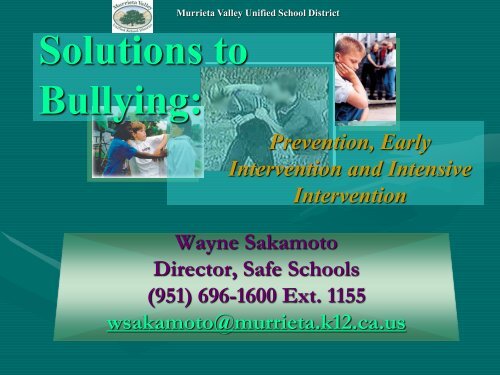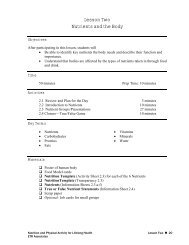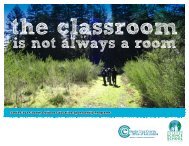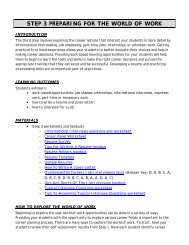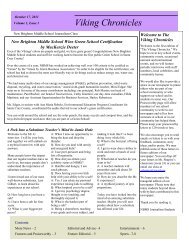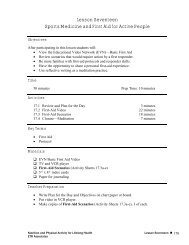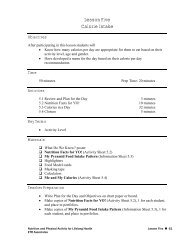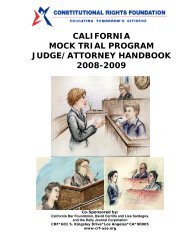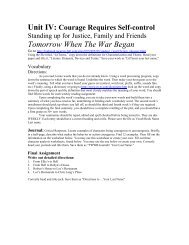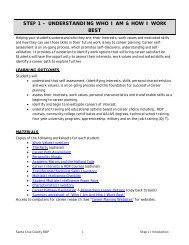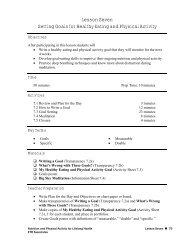Bullying Prevention Classroom Strategies - Santa Cruz County ...
Bullying Prevention Classroom Strategies - Santa Cruz County ...
Bullying Prevention Classroom Strategies - Santa Cruz County ...
Create successful ePaper yourself
Turn your PDF publications into a flip-book with our unique Google optimized e-Paper software.
Murrieta Valley Unified School DistrictSolutions to<strong>Bullying</strong>:<strong>Prevention</strong>, EarlyIntervention and IntensiveInterventionWayne SakamotoDirector, Safe Schools(951) 696-1600 Ext. 1155wsakamoto@murrieta.k12.ca.us
Objectives• Greater Ability to Recognize <strong>Bullying</strong>• Increased Knowledge and Skills in Identifying andImplementing <strong>Strategies</strong>• Ability to Implement a Steps At Your School Site(s)and in the <strong>Classroom</strong>
Key Questions• What is <strong>Bullying</strong> and Cyberbullying?• What is the Impact of <strong>Bullying</strong>?• How Prevalent is <strong>Bullying</strong>?• What Can I do About <strong>Bullying</strong>?
Model Whole School ApproachStep by Step Systematic Approach:• I. Develop a task force• II. Develop a definition• III. Develop policies and protocols• IV. Assessment• V. Training• VI. Action Planning• A. Universal• B. Early Intervention• C. Intense Intervention• VII. Evaluation
Key Questions• What is <strong>Bullying</strong> and Cyberbullying?• What is the Impact of <strong>Bullying</strong>?• How Prevalent is <strong>Bullying</strong>?• What Can I do About <strong>Bullying</strong>?
Objective One: GreaterKnowledge of Key Definitions• <strong>Bullying</strong>• Cyberbullying• Bully/Perpetrator• Victim/Target• Bully-Victim/Provocative Victim• Direct <strong>Bullying</strong>• Indirect <strong>Bullying</strong>• Relational Aggression
<strong>Bullying</strong> Definition1. Specific Type of Aggression– Verbal– Physical– Psychological2. Behavior is Intended to Harm or Disturb3. Carried Out Repeatedly and Over Time4. Imbalance of Power1. Physical2. Psychological
Cyberbullying Definition• Use of Modern Communication Technologies:• Email• Instant Messaging• Chat Rooms• Web Sites• Social Networking Sites• Cell Phones and other forms of technology• To Intentionally Embarrass, Humiliate,Threaten or Intimidate an Individual or Group• To Attempt to Gain Power and Control
Administrative Responses to• Nexus to the SchoolCyberbullying• Victim Impact Statements– How has this impacted your attendance– How has this impacted your academics– How has this impacted you at school• Bystander/Friend/Perpetrator Statements• Have Other Students Shared the Text, VideoEtc. At School?• Has the Cyberbullying Caused School <strong>Bullying</strong>
Bully-Victim/Provocative Victim• The Terms are Used Interchangeably in SomeResearch• Roughly 6% of Students Fall in This Category• Two Definitions:1. Someone that get’s bullied, then finds weakerstudents to bully – “Kick the dog” behaviors2. The Target Somehow Provokes the Attack andUsually Feels They are the Victim
Direct <strong>Bullying</strong>• Physical Acts• Threats• Intimidation• Verbal Abuse• Taunting• Other?
Indirect <strong>Bullying</strong>• Making Faces• Obscene Gestures• Exclusion• Rumors• Cyberbullying• Other?
Relational Aggression• Usually Refers to Girl to Girl <strong>Bullying</strong>• Damage Social Standing in the School• Damage Reputation• Damage Friendships/Relationships• Manipulation of Friendships• Withhold Friendship• Other?
Key Questions• What is <strong>Bullying</strong> and Cyberbullying?• What is the Impact of <strong>Bullying</strong>?• How Prevalent is <strong>Bullying</strong>?• What Can I do About <strong>Bullying</strong>?
Health Consequences of <strong>Bullying</strong>(Fekkes et al., 2003)Bullied Not bulliedHeadache 16% 6%Sleep problems 42% 23%Abdominal pain 17% 9%Feeling tense 20% 9%Anxiety 28% 10%Feeling unhappy 23% 5%Depression scalemoderate indication 49% 16%strong indication 16% 2%
Key Questions• What is <strong>Bullying</strong> and Cyberbullying?• What is the Impact of <strong>Bullying</strong>?• How Prevalent is <strong>Bullying</strong>?• What Can I do About <strong>Bullying</strong>?
Prevalence• California Healthy Kids Survey (2007-09)• Fifth Grade N= 202,714• Been Hit or Pushed– Most of the time – 7%– All of the time – 5%• Have Hit or Pushed Others– 3 or more times – 13% (Female 8% Male 19%)• Mean Rumors Spread About You– Most of the time – 8%– All of the time – 6%• Have Spread Mean Rumors About Others– 3 or more times – 6%
Prevalence• California Healthy Kids Survey (2009-10)– Seventh Grade N= 854– Been Hit or Pushed• Most of the time – 4% (F=3%; M=6%)• All of the time – 4% (F=3%; M=4%)– Hit or Pushed Others• 2 or more times in past 12 months – 15% (F=7%; M=22%)– Mean Rumors or Lies Spread About You• Most of the time – 3% (F=4%; M=3%)• All of the time – 3% (F=4%; M=2%)– Spread Mean Rumors or Lies About Others• 2 or more times in past 12 months – 6% (F=6%; M=6%)– Had Mean Rumors or Lies Spread About you on the Internet• Most of the time – 1%• All of the time – 1%
CHKS Caveat1. Reliability of Self-Reports2. Academic Factors of Respondents• Mostly A’s: 7 th – 22%; 9 th – 17%; 11 th – 14%• A’s and B’s: 7 th – 32%; 9 th – 29%; 11 th – 27%• Mostly B’s: 7 th – 7%; 9 th – 8%; 11 th – 9%• B’s and C’s: 7 th – 21%; 9 th – 22%; 11 th – 25%• Mostly C’s: 7 th – 5%; 9 th – 6%; 11 th – 9%• C’s and D’s: 7 th – 8%; 9 th – 10%; 11 th – 11%• Mostly D’s: 7 th – 2%; 9 th – 3%; 11 th – 2%• Mostly F’s: 7 th – 3%; 9 th – 4%; 11 th – 2%
Key Questions• What is <strong>Bullying</strong> and Cyberbullying?• What is the Impact of <strong>Bullying</strong>?• How Prevalent is <strong>Bullying</strong>?• What Can I do About <strong>Bullying</strong>?
The Resiliency WheelMitigate Risk Factors in theEnvironment5. Set &CommunicateHigh Expectations6. Provide Opportunitiesfor MeaningfulParticipation1. Increase ProsocialBonding4. Provide Caring &Support3. Teach"Life Skills"2. Set Clear, ConsistentBoundaries12/14/2012Build Resiliency in theEnvironmentReprinted from Resiliency In Schools: Making It Happen For Students & Educators by NanHenderson & Mike Milstein, published by Corwin Press, Thousand Oaks, CA, 1996
<strong>Prevention</strong> ModelIntensiveIntervention5-10%Early Intervention10-15%Whole School80-90%
Universal <strong>Prevention</strong>• Build a positive school/classroom climate• Social-Emotional Skill Development• Improve the physical environment– CPTED• Link to School Safety Plan (EC 32280)• Proactive approaches– Curriculum– Program– Youth Involvement
Universal <strong>Prevention</strong>• Assemblies• Character Development Programs• Reading Day – Focus on <strong>Bullying</strong> <strong>Prevention</strong>• Student Leadership• Peer Helpers/Peer Listeners• Link Crew
Universal <strong>Prevention</strong> in the<strong>Classroom</strong>• <strong>Classroom</strong> Meetings• <strong>Classroom</strong> Setting (CPTED)• Bulletin Boards• Posters• <strong>Classroom</strong> Rules• Reading Materials and Resources on <strong>Bullying</strong>• Assignments on <strong>Bullying</strong>• Teachable Moments• Empathy Development
<strong>Bullying</strong> <strong>Prevention</strong>• <strong>Classroom</strong> Meetings• <strong>Classroom</strong> Setting• Literacy
<strong>Classroom</strong> Meetings• Getting Students Actively Engaged• Decreases Discipline Issues in <strong>Classroom</strong>• Ties to Language Arts, Health, Social Science andHistory• Assists in Building <strong>Classroom</strong> Culture• Builds Sense of Belonging• Empowers ALL Students• Creates Ownership and Pride• Generates Excitement and Energy
<strong>Classroom</strong> Meeting Critical• What Did You See?Questions• Does That Happen Here?• How Does That Make You Feel?• What Can We Do About It?
Words Hurt
<strong>Classroom</strong> Meeting Critical• What Did You See?Questions• Does That Happen Here?• How Does That Make You Feel?• What Can We Do About It?
<strong>Classroom</strong> Setting• Warm and Inviting• Sends Subtle Messages• Bulletin Boards– Essays– Drawings• Posters• Quotations
Posters
Drawings
Quotes• Our lives are not determined by what happens to us but by howwe react to what happens, not by what life brings to us, but bythe attitude we bring to life. A positive attitude causes a chainreaction of positive thoughts, events, and outcomes. It is acatalyst, a spark that creates extraordinary results. -Anon.• I cannot believe that the purpose of life is to be happy. I thinkthe purpose of life is to be useful, to be responsible, to becompassionate. It is, above all to matter, to count, to stand forsomething, to have made some difference that you lived at all.-Leo Rosten• You make the world a better place by making yourself a betterperson.-Scott Sorrell
Quotes• A kind word can warm three months of winter.-Japanese Proverb• No Act of Kindness, no matter how small, isever wasted. -Aesop• Let there be peace on earthAnd let it begin with me.~Seymour Miller & Jill Jackson, "Let There BePeace on Earth," 1955
Internet Resource• http://www.jaguared.com/default.aspx• http://www.yesnet.yk.ca/schools/wes/projects/bullying/bullying.html
<strong>Prevention</strong> ModelIntensiveIntervention5-10%Early Intervention10-15%Whole School80-90%
• Staff Intervention• Administrative Intervention• Skill Development– Perpetrator– Victim– Bystanders• Counseling/Mental Health– Perpetrator– Victim– Student Assistance Program• Mentoring• Support• Parent InvolvementEarly Intervention
Early Intervention in the <strong>Classroom</strong>• Bully Box• Dear Bully…• Guest Speakers• Victims of <strong>Bullying</strong> Panel– Empathy Development– Changing Norms• Story Tellers/Readers• Teachable Moments• Identify Bullies, Victims and Instigators• The “Radar Screen” Approach
Characteristics of Victims• More Anxious and Insecure• Greater Levels of Depression• More Loneliness and Unhappiness• Lack Social Skills• Poor Social and Emotional Adjustment• Difficulty Making Friends/Lack of Friends• Cautious, Sensitive, and Quiet• React by Crying and Withdrawal (Lower Grades)• Low Self-Esteem• Negative View of Themselves• Males are Generally Weaker Than Their Classmates• Boys Have Close Relations with Mothers
Warning Signs - Victim• Depression• Anxiety• Drop in Grades• Drop in Attendance• Psycho-somatic Symptoms• Signs of Physical Confrontations• Torn Clothes, Cuts, Bruises, etc.• Loss of personal possessions• Few Friends• Loner/Isolated• Poor Self-esteem• Afraid to go out to Play
Characteristics of Bullies• Higher Levels of Conduct Problems• Dislike School/Poor School Adjustment• Positive Attitude Toward Violence and Use ofViolence• Impulsivity• Strong Need to Dominate• Little Empathy Toward Victims• Positive View of Themselves• Greater Ease in Making Friends
Warning Signs - Bully• Maliciously Teases, Threatens, or Strikes Out• Hot-tempered• Impulsive• Hard Time Following Rules• Aggressive Toward Adults• Tough/Mean Spirited• Lack of Empathy• Involved in Other Anti-social Behaviors
Immediate Action – Teacher1. Stop the behavior2. Talk to the students3. Determine if bullying is involved4. For Second offense talk to students separately5. If normal conflict conduct conflict resolution6. If bullying is SUSPECTED notify bully to stop actions7. Observe further interactions8. Support Victim9. Notify Parents and Keep Them in the Loop10. Notify Administrator
Immediate Action - Administrator• Stop the <strong>Bullying</strong>• Interview Separately– Talk with victim– Talk with perpetrator– Talk with by-standers/witnesses/instigators• Support the Victim• Immediate Consequences• Skill Development• Document, document, document!• Follow-up
Talk With Victim• Tell them:– You are concerned– They will be protected– Their needs will be taken care of• Place child at ease• Collect information• Encourage the expression of emotions• Provide support and encouragement• Inform of general actions• Have child agree to report further bullying• Gauge distress level - Refer if needed• Communicate with parents• Follow-up
Talk With Perpetrator• Talk With Separately• Do not tell them victim reported• Discuss Rules and Consequences• Notify them that they will be monitored• Document• Alert appropriate staff• Notify parents• Follow-up
Youth Leadership• Elementary or SecondarySchool Approach– Elementary by grade level– Secondary by cliques orleaders• Lunch or Pull-out• Six Sessions• Follow-up Meetings• Leadership = Influence• Skill Development– Leadership– Communication Skills– ConflictResolution/Mediation– Assertiveness– Understanding Perspectives• Empowerment• Support• Recognition
SAMPLE CLIQUESHICKS STONERS GOTHSCOWBOYS SKATERS TAGGERSPARTY CREWS JOCKS REBELSGANGSTERS SKINHEADS SURFERSTECHIES PREPPIES REDNECKSETHNIC GROUPINGS
GOALS• Changing Peer Group Norms– Rumor Control– Pro-Social Responses to Disrespect– “Friends” Instigating Violence– Getting Youth Involved in Safety– Increasing Positive Interactions Between Cliques– Reducing Exclusion– Reducing Tensions and Negative Conflicts• Counter Social Branding
Social Branding• What is Cool?• How Do I Want to Define Myself?• How is the Ideal Man Defined?• How is the Ideal Woman Defined?• How Do I Send That Image Out to Everyone?
<strong>Prevention</strong> ModelIntensiveIntervention5-10%Early Intervention10-15%Whole School80-90%
Intensive Intervention• Supervised Lunch/Recess• Suspension/Expulsion• SARB• Re-entry Plan• Counseling Mental Health/Referral to Wrap Around Services• Assigned a Mentor• Restorative Justice Model– Restitution – Pay Something Back Not Monetary– Empathy Development– Skill Development• The “Radar Screen” Approach
Intervene With The Bully• Determine Cause of <strong>Bullying</strong>• Identify Potential Bully Type– Social Climber Bully– Power and Control Bully– Revenge Bully– Anger Bully– Racial/Intolerance Bully– Hollywood/Bored/Instigator Bully• Continuous Monitoring• Appropriate Intervention Services
Girls• Reminder: Indirect <strong>Bullying</strong> and Direct <strong>Bullying</strong>• Rate not as High as Boys• Data Versus Reality• Social Networking Sites• Girl Fight Popularity on Net
Crime <strong>Prevention</strong> TriangleLocation/TimeIntensiveIntervention5-10%Early Intervention10-15%VictimWhole School80-90%Perpetrator
Critical Discussion - Empathy• What is Empathy?• How Can Empathy Help With SchoolSafety?• How Does Empathy Develop?• Can the School Facilitate theDevelopment?
Empathy• Ability to Identify Another Person’sEmotional State• Ability to Understand Another Person’sSituation• Ability to ACT Upon the State orSituation
Empathy in Schools• What Does an Empathetic School LookLike?• What is the Correlation Between Empathyand School Safety?
How Does Empathy Develop?• Family• Community– Neighborhood– Mass Media• Individual Influences• Peer Influence
Can the School Facilitate theDevelopment of Empathy?• Whole School• <strong>Classroom</strong>• Playground• Lunch Area• Parents
Fostering Empathy• Teachable Moments• <strong>Classroom</strong> Meetings on Empathy/Kindness• Intervene Early– Focus on Behaviors not the Student• Recognize Empathetic Behaviors– Have Students Share How They Have Helped• Role Modeling• Role Playing– Role Reversal• Point-Counter Point• Class Discussions– Literature– Movies• Perspectives of ALL Characters
Intensive Intervention• Student Attendance Review Board– Primary– Secondary• Expulsion– EC 48900 and 48915• Citation Program• Arrest• Temporary Restraining Order• Involuntary Transfer• Counseling/Mental Health Services– Cognitive Restructuring• Case Management• Restorative Justice Model• Re-entry Contract• Student Assistance Program
Intensive InterventionStudent Attendance Review Board – The Education Code allows for the use of the Student AttendanceReview Board (SARB) for truancy/absentee issues AND behavioral problems. The SARB process generally includes apre-SARB intervention at the school site. If the behavioral problems do not improve the school site will refer the studentand family to the district-wide SARB hearing. The district SARB, in partnership with law enforcement, district attorney’soffice, probation and juvenile justice can mandate counseling, mental health, parenting classes, etc. to illicit behavioralchanges. Should behaviors continue, the parent and student are referred on to juvenile justice.West Sacramento School District has implemented a successful SARB program to reduce bullying in both primaryand secondary schools.SARB – Does our district have SARB protocols in place for bullying?Suspension/Expulsion – Persistent bullying will result in either suspension or expulsion and is based upon theschool district bullying, harassment or behavioral policies.Education Code 48900 and 48915Citation/Arrest – Schools have used citation programs to reduce fighting on campus. These programs generallywork very close with law enforcement, district attorney’s office and the court system. When students fight they are given acitation by the School Resource Officer (SRO), or in some cases the school administrator. The citation is forwarded totraffic court where the first offense may result in a designated fine. Further offenses equals higher fines. Should the familynot be able to pay the fine, the student is given community service hours. This program has effectively reduced fights onseveral school campuses. The program may be modified to deal with physical acts of severe bullying.<strong>Bullying</strong> that includes physical injury to the victim should be referred to the School Resource Officer for arrest onassault charges if the attacking student is above the age of twelve years old. The school should also follow suspensionprotocols under Education Code 48900 or 48915.Penal Code 422. Making Terroristic ThreatsPenal Code 415. Disturbing the PeaceAny of the following persons shall be punished by imprisonment in the countyjail for a period of not more than 90 days, a fine of not more than fourhundred dollars ($400), or both such imprisonment and fine:(1) Any person who unlawfully fights in a public place or challengesanother person in a public place to fight.(2) Any person who maliciously and willfully disturbs another person byloud and unreasonable noise.(3) Any person who uses offensive words in a public place which areinherently likely to provoke an immediate violent reaction.Temporary Restraining Order – The victim’s family may ask the district attorney’s off ice to file a temporaryrestraining order (TRO) that will keep the perpetrator away from the victim’s
home and a given range of distance in public places. This can create problems of enforcement on a school campus.Class scheduling should take into consideration the issue of a TRO. The school must comply with court orders andmay seek some modifications on the TRO to ensure that both students are provided a Free and Appropriate PublicEducation (FAPE). Please note local or state mandates differ from region to region. The school must check with theirattorneys regarding district or local protocols that may impact a TRO.Involuntary Transfer – Some school districts have involuntarily transferred persistent bullies to other schools in thedistrict. Transportation issues including costs are typically the responsibility of the parents or guardians. Care shouldbe given to inform the site administrators and teachers of the school of transfer regarding dangerous pupils. While aninvoluntary transfer may assist with issues a TRO presents, it may do very little to reduce bullying behaviors by thetransferred student.Re-entry – To effectively change behavior, schools must include a comprehensive and enforceable re-entry plan for thestudent that includes social skill development during the term of suspension or expulsion. Re-entry should also includedirect placement into a student assistance program immediately upon reinstatement. The re-entry plan must bespecific in types and duration of parenting classes for the parent/guardian and counseling or mental health sessions forthe student. The plan must include placement into student assistance programming upon return and be signed anddated by all parties.What do you currently do for suppression?Do you have a re-entry contract with the perpetrator? IX. Evaluation PlanHow will you measure your efforts?Measure against baseline dataPositive changes in student, teacher and parent surveysPositive changes in focus groupsObservationsProcess dataNumber of teachers trainedNumber of parents trainedCurriculum in classroomsPrograms implementedList other:Impact dataReduction of bullyingSafer campusGreater attendanceReduction of suspensionsReduction of expulsionsList other:
Teacher Tips• Proactive is Easier Than Reactive• Be Aware• Identify the Players• Environmental Design– Seating Assignments– Isolated Areas– Student Movements– Passing Periods/Transitions
Teacher Tips (Continued)• Develop A Positive <strong>Classroom</strong> Culture (TeachStudents Not Just Subjects)– Establish Rapport– <strong>Classroom</strong> Rules– Fun AND Secure– Model Appropriate Behaviors• No Dumb Answers– Find All Students’ Strengths• Allow All Students’ to Exhibit Strengths
Teacher Tips (Continued)Develop A Positive <strong>Classroom</strong> Culture: Teach Students Not Just Subjects(Continued)– Do Not Allow Teasing, etc.– Discipline in a Low-Key Fashion– Avoid Power Struggles– Teach Skills for Youth Success– Utilize <strong>Classroom</strong> Meetings• Know When to Refer toPrincipal/Counselors
Tips for Meeting With Parents• Listen to Concerns• Paraphrase Concerns• Discuss Each Element of the <strong>Bullying</strong>Definition• Discuss Current <strong>Strategies</strong>• If it Does Not Fit – Remind Parents We WillStill Take Action• Document!
Parent Tips• Be Aware of Warning Signs• Do Not Overreact– Gain Information• Do Not Minimize• Take It Seriously• Work on Child’s Social Skills• Listen to Your Child• Work With the School
Parent Tips (Continued)• Don’t:– Be the Cynic - “You’re over-reacting”– Be the Martyr - “That’s nothing, when I was a kid…”– Be the Brick Wall - Not listening and jumping toconclusions “ You should have…” ” I would have…”– Be the Interrogator - “I want to know everything”– Be the Bully - “Stick up for yourself” “If you get a blackeye the other guy better have two black eyes”– Be the Rescuer - “Leave it to me, I’ll take care of it”
Parent Tips (Continued)• Do:– Be the Listener - Do not jump to conclusions– Be the Clarifier - Restate facts– Be the Supporter - See their side• Let Your Child Know:– That you are pleased they told you– That you believe them– That it is not their fault– You are sorry it happened– That you will help with solutions
Resources/Bibliography• Aggression Replacement Training, Goldstein, Arnold P., Glick, Barry, et alResearch Press (800) 519-2702 www.researchpress.com• Steps to Respect: A <strong>Bullying</strong> <strong>Prevention</strong> Program, Committee for Children,2001. (800) 634-4449 www.cfchildren.org .• Bully Busters: A Teacher’s Manual for Helping Bullies, Victims, andBystanders, Horne, Arthur M., and Newman, Dawn A., andBartolomucci, Christi L. Research Press (800) 519-2702www.researchpress.com• Blueprints for Violence <strong>Prevention</strong>: Book Nine <strong>Bullying</strong> <strong>Prevention</strong> Program,Olweus, Dan and Limber, Sue University of Colorado at Boulder.(303) 492-8465.• Stop <strong>Bullying</strong>! Guidelines for Schools, New Zealand Police
<strong>Classroom</strong>Discussion/Presentation• Grade Appropriate Definition of <strong>Bullying</strong>• Teasing Versus <strong>Bullying</strong>• What Does <strong>Bullying</strong> Look Like?• What Can We Do About it?
Hero in the Hallway


